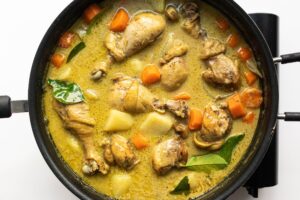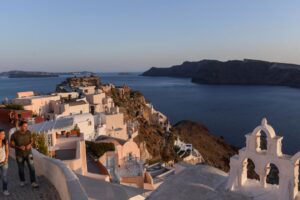Typically a combination of milky tea and chewy tapioca ‘pearls’, the beverage also known as boba tea is so beloved it was the subject of a years-long legal battle.
As much a textural marvel as a refreshing drink, bubble tea is one of Taiwan’s most renowned cultural exports. The eponymous ‘bubbles’ aren’t the result of carbonation, but a pile of chewy, sweet, balls of starch that sit at the bottom of the cup and are sucked up along with the liquid through an extra-wide straw.
The first iterations of the drink — also called boba tea — emerged in the 1980s out of Taiwan’s traditional tea shops, and today boba tea shops remain a fixture in most neighbourhoods across the island. Rather than sit-down spots, these are usually grab-and-go establishments, operating at devilishly fast speed.
Bubble tea has since proliferated across the world, with dedicated shops popping up everywhere from Berlin to Brasilia, and you’ll find starch pearls (as the bubbles or boba are also known) in much more than milk tea. They’re served in all sorts of ways, whether that’s in rose-scented lattes or even as a pizza topping.

Origins
Texture is an important component of Taiwanese cuisine; a lot of dishes on the island exist more for their mouthfeel than flavour, such as crunchy pig’s ears and bouncy fish balls. On the dessert end, chewy starch-based toppings have been a fixture in Taiwan for generations, usually served over ice or in sugar water.
Bubble tea as we know it today came into existence almost four decades ago. Two tea houses — Chun Shui Tang in the central city of Taichung and Hanlin Tea Room in the southern city of Tainan — both claim to have invented the drink in 1986. “When we started to drink iced tea, we found there was a lot of variation. So my dad started to think, what else can we do?” says Angela Liu, the daughter of the founder of Chun Shui Tang. The story goes that her father, Liu Han-Chieh, asked his staff to experiment with different toppings and textures, and one of them decided to add tapioca balls — thus the beverage was born.
Over in Tainan, the founder of Hanlin Tea Room was inspired by the dessert stalls at his local traditional market. “He’d been thinking for a couple of days how to increase the value of his drink, when he suddenly noticed the starch balls in sugar water that a grandmother was selling,” says Jack Huang, an operations manager at Hanlin. “He thought: why is this only paired with sugar? So he added it to tea.”
It’s impossible to definitively verify either story, but the claim to ownership was at one time so fierce that the two tea shops were embroiled in a decade-long lawsuit. In 2019, the court eventually concluded that because bubble tea is not a patented product, who actually invented it is irrelevant.

How bubble tea is made
At its most basic, boba — the pearls themselves — are made with a collection of starches, brown sugar and water. The ingredients are rolled together into small balls, which are boiled in water until they turn gummy, chewy and glossy. Tapioca starch — made from cassava root — is the main starch because of its soft and supple texture, but it’s sometimes mixed with sweet potato starch, which gives it a firm finish. The brown sugar, meanwhile, is what’s responsible for boba’s signature dark caramel colour. Because freshly made boba are only good for one or two days, many commercial manufacturers also throw in additives to make it shelf stable.
From there, it’s all about what type of drink you want to have it with. Early renditions of boba tea were made with sweet, iced milk tea made with black tea and lactose-free creamer. Times have changed, however, with a huge variety available, such as green, high-mountain oolong, jasmine and tieguanyin (an oolong varietal known for its coffee-like roasted aroma) — sometimes mixed, or even substituted, with fruit-based drinks. The lactose-free creamer of yesteryear, meanwhile, has largely been replaced with full-fat milk, or sometimes non-dairy alternatives.

Where to drink bubble tea in Taipei
In the Taiwanese capital, single-origin teas, high-quality full-fat milk and lightly coloured pearls are in vogue, with an emphasis on quality over quantity. Here are three of the city’s best boba tea shops.
1. Guiji
With several branches around the city, Guiji is known for its bright orange tapioca balls flavoured with honey, and a quirky menu that rotates around high-quality teas mixed with fruit. The shop does a wonderful tieguanyin tea which is then infused with the bright acidity of kumquat. The menu also regularly features starfruit, winter melon, apples and lime.
Inspired by British tea culture, John Tea Company specialises in creamy milk tea made with black tea leaves sourced from India, Taiwan and Sri Lanka. The milk comes from Liu Jia Village, a cooperative of dairy farmers in southern Taiwan known for their rich, full-fat milk. The pearls, which are optional, are small, white and opaque. Each of the five Taipei locations is decked out in royal blue signage and motifs inspired by the East India Company.
3. Jiate
Meaning ‘drink tea’ in Taiwanese, Jiate champions local, single-origin teas. Indulge in the sweet raspberry-like notes of Sun Moon Lake’s black tea, or the floral aromatics of the island’s high-altitude oolong from Alishan. As for additions, there’s the usual boba, as well as green tea jelly or aloe vera. Milk is optional. Jiate also serves drinks with a sweet-and-savoury cheese foam topping.
Source : National Geographic

























